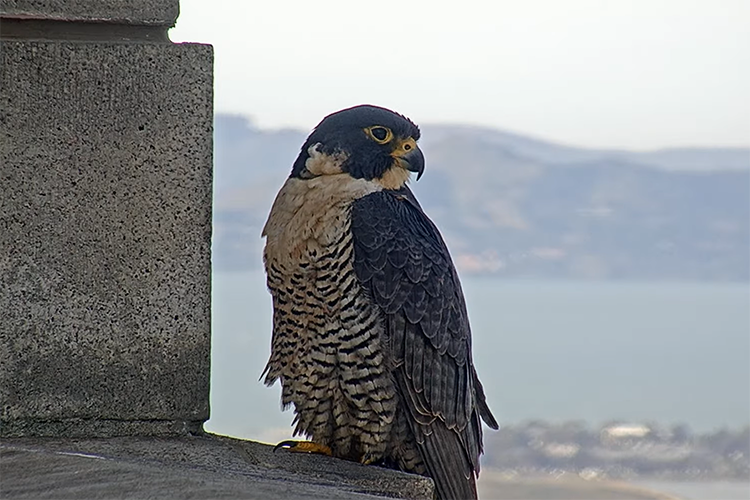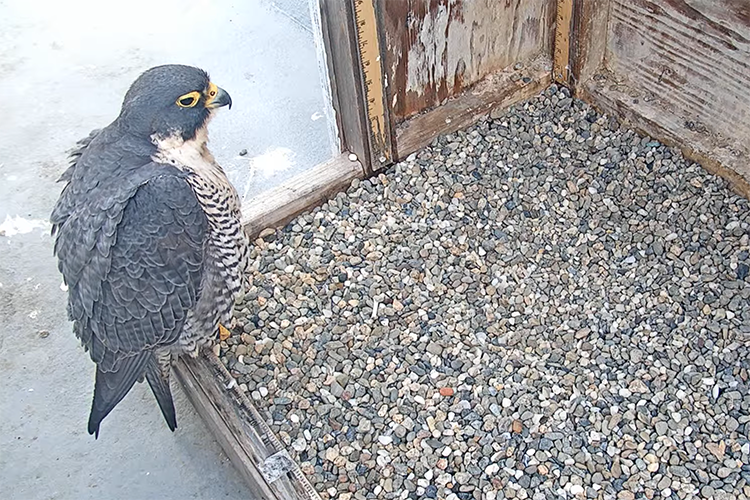Annie the falcon, presumed long gone, returns to Berkeley’s Campanile
Grinnell's longtime mate defied all odds, is back on her nest, readying it for this year's eggs. Says one ornithologist, 'Sometimes science isn't an exact science.'

March 1, 2022

Just 10 minutes after returning to the Campanile, after a week’s absence, Annie the falcon was back on her nest, readying it for egg-laying. (Cal Falcons image)
Cal Falcons ornithologist Sean Peterson was working at his computer this morning around 11:30 when he saw on a stream from a UC Berkeley webcam that a bird was perched on the Campanile. And it was sitting in the spot where Annie, the campus’s beloved peregrine falcon that’s been missing for at least a week, liked to sit.
“When I zoomed in, it was immediately clear it was Annie!” he said. “At which point, I said some words that I’m glad my three-year-old son wasn’t around to hear.”
Defying the odds, Annie has returned to her nest on the 307-foot-tall tower, where she and mate Grinnell have lived and raised their young since 2016. Yesterday, bird experts and volunteers sadly, but resolutely, went public with news that Annie likely was injured, dead or had abandoned her territory.
“She’s been gone a week, a week! Like, gee. We’ve had a lot of people watching the (three web) cameras (on the tower); it’s not like we missed something,” said Mary Malec, who is on a team of volunteers who have monitored the area during Annie’s absence. “I don’t know what to say. I’m flabbergasted. I’m humbled. I am humbled. We don’t know why this happened.”
Peregrine falcons are very predictable — “no one disappears for a week and comes back,” explained Malec. “They are very good parents, they’re very protective of their territory, and once they have eggs and chicks, they will defend their territory. They’re known to be faithful to their site more than to their mate. And they don’t just willy-nilly leave their mate.”
Weeks before the time in March when she usually lays eggs, Annie vanished, and several females quickly arrived at the tower to eye her home and her mate. With Annie back, those females are gone.
Lynn Schofield, another Cal Falcons ornithologist, said that before noon today, Annie “hopped into her nest … like she had never left.” Annie’s making an impression for her eggs in the nest, she said, and displaying a brood patch — a bare area on her chest where Annie’s lost her downy feathers so she can get skin-on-egg contact during incubation.
So, where did Annie go?
“I’m at a total loss,” said Peterson. “This flies in the face of everything we know about peregrine falcon biology and territorial behavior, especially during the breeding season. Grinnell certainly was acting like she wasn’t coming back. He was fairly actively courting the new juvenile bird at the Campanile.”
Peterson said perhaps Annie got injured and stayed away to recover, but that she appears healthy.
Perhaps, said Schofield, but just perhaps, Annie left to avoid a violent encounter with other falcons cruising by, looking for real estate.
Schofield and Peterson, who are married, said they were so resigned to Annie’s demise that they’d contemplated naming the juvenile, if she became Grinnell’s next mate. The name might have been Alex, said Schofield, part of the last name of Annie Alexander, the explorer and naturalist who founded the UC Museum of Paleontology and the Museum of Vertebrate Zoology. Annie was named for Alexander, too.
The past five months have been unusually rocky for the falcon pair. Grinnell was attacked in October, released from hospitalization in November, but didn’t win Annie back until the start of 2022. Annie had been flirting with another male — ironically, one that injured Grinnell — while Grinnell was mending. And Grinnell had three female falcons nearby after Annie took off late last month.
Time will tell if Annie and Grinnell resume their usual life together. Malec said it took the pair a long time to display bonding behavior after Grinnell returned from Lindsay Wildlife Rehabilitation Hospital. It was first seen on a webcam on New Year’s Day.
“It’s like they are an almost-new couple that has to get to know each other again, to start talking to each other, and to go through the necessary rituals so that she’ll start producing eggs, and he’ll respond in the right way,” said Malec. “They might need some time to get comfortable again.”
But by early afternoon on Tuesday, the two birds were sitting in view of each other and occasionally vocalizing, said Peterson, “almost like nothing happened.”
“It’s a bit of a humbling experience to see something like this happen that flies in the face of everything we think we know,” he said. “Sometimes science isn’t an exact science.”